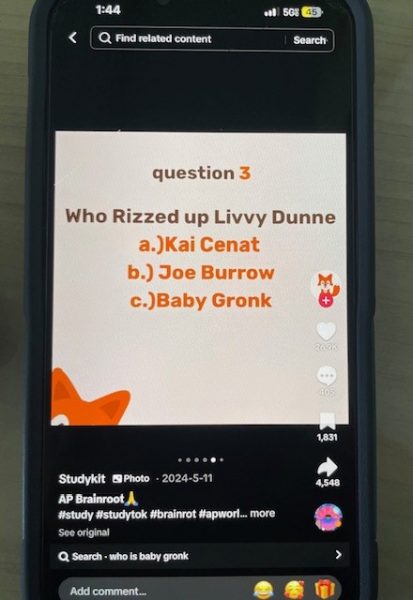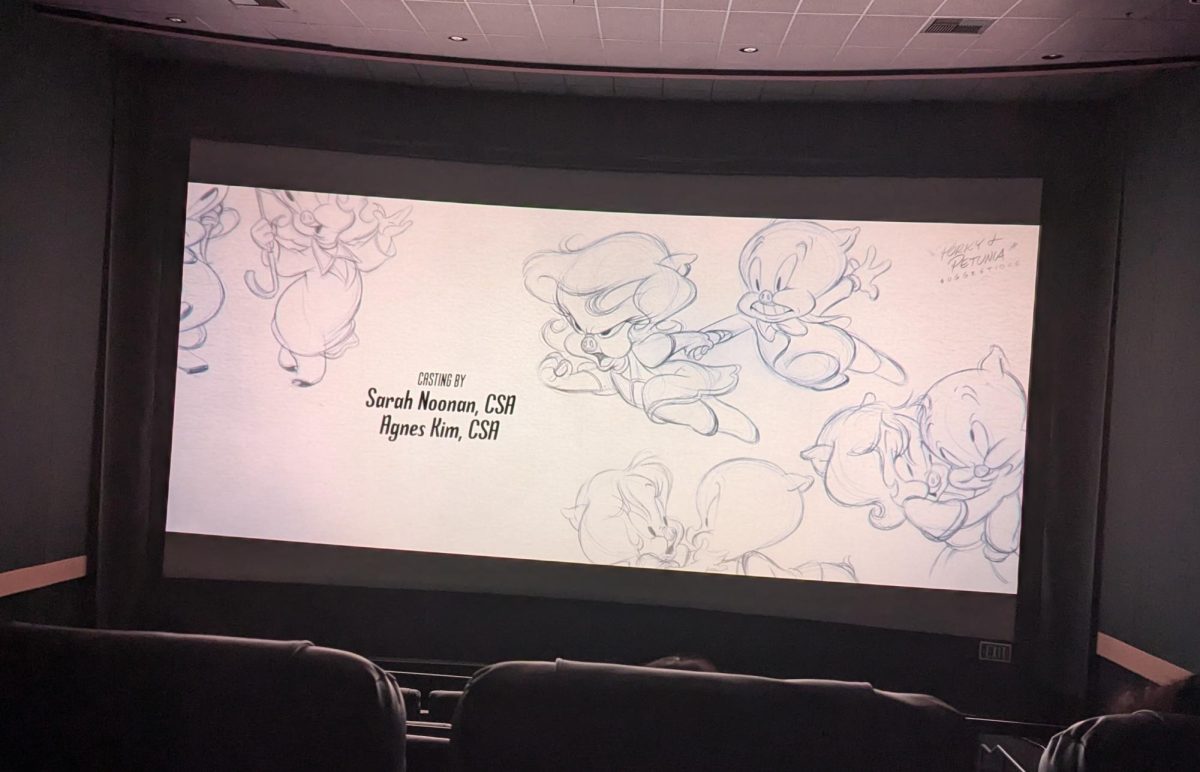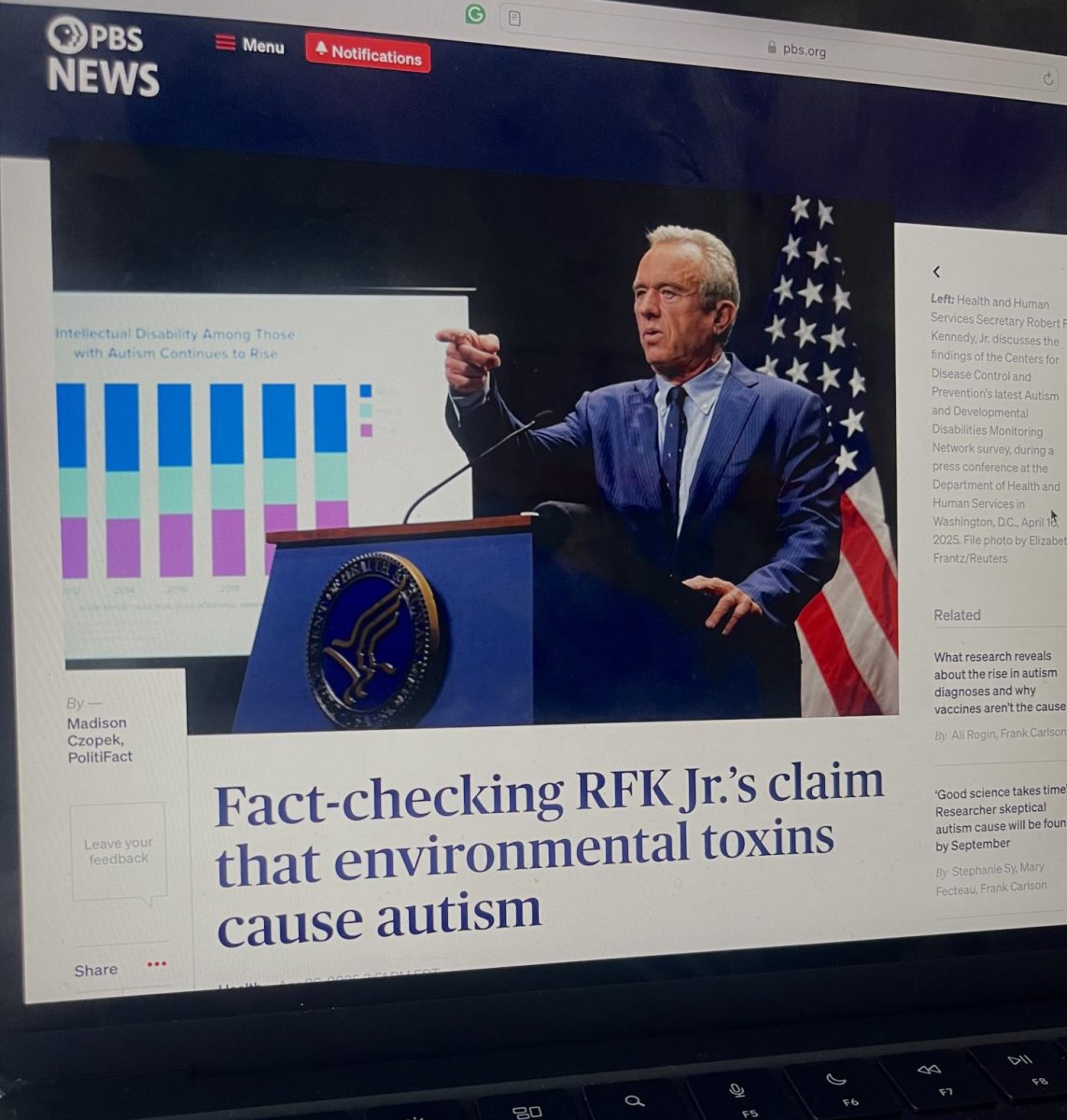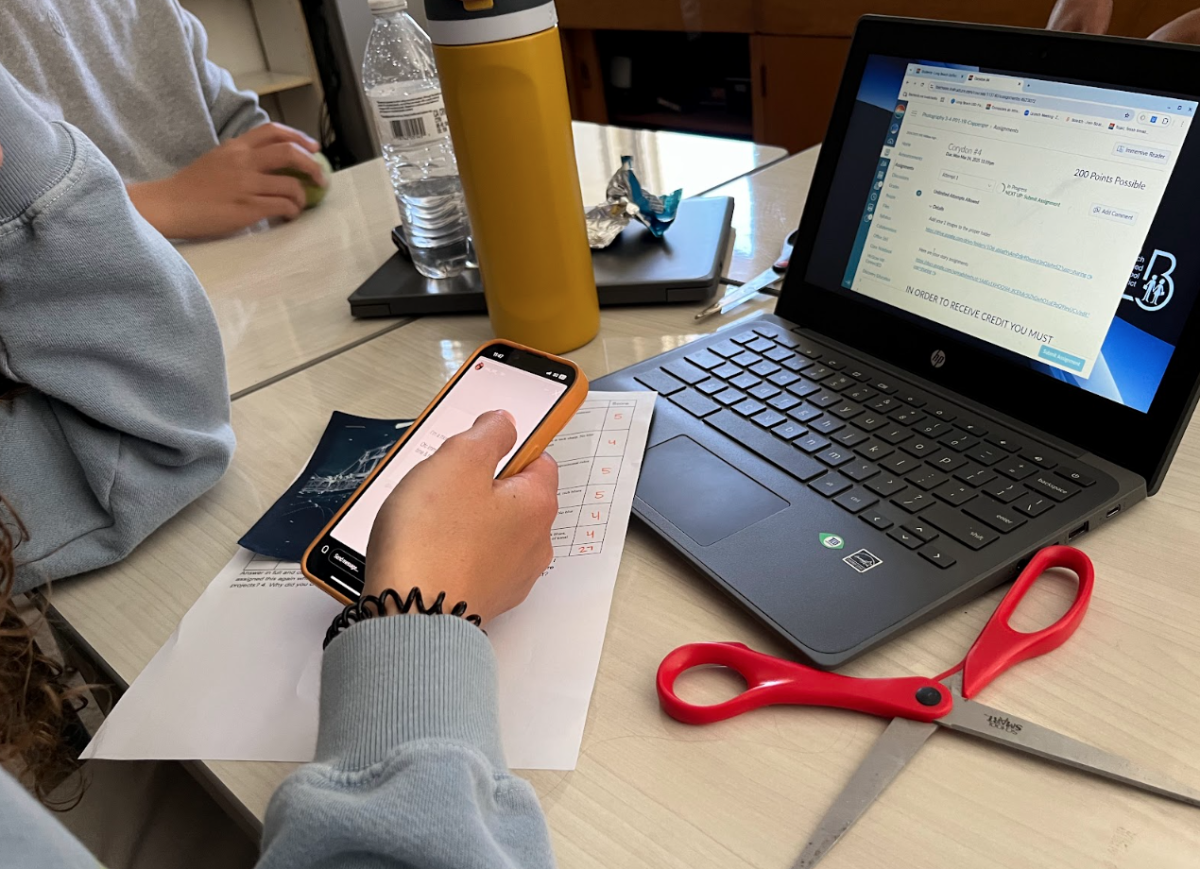POV: You look down at your phone to see you have incoming call from Freakbob, do you pick up? Or will you decline? If you’re employed and have no idea what this means, this is internet slang referred to as brainrot. Social media has always had an influence over younger consumers by making phrases and memes so popular they infect viewer’s vocabulary. Constantly there are new waves of slang that wash over kids on social media, becoming popularized and widely used in almost every conversation.
Phrases such as “bet,” “gucci,” or “yeet,” are examples of slang that have made it off of the internet and cemented themselves into the everyday language of kids. The amount of internet lingo being used in every day conversations has been associated with another concerning name, brain rot.
Sofia Alas, a 9th grader in QUEST, says, “My very close friend often DMs me reels about Ninja’s low taper fade or the Talk Tuah podcast. He often speaks and communicates in brainrot to me.”
People have begun to make the assumption that overusing this slang in daily conversation is what’s “rotting brains”, but this extravagant use of slang is a sign that kids are online too much. People tend to judge teens when they say things like “alpha sigma rizz” in real life, but this brainrot slang is doing more good for teens than bad.
According to the Oxford University Press, who had brain rot as their word of the year, “Brain rot” is a term that refers to the effects of being “chronically online.” Being “chronically online” is when a person spends a great majority of their time consuming media online and on social media instead of being involved in the real world. Although it’s not an official diagnosis, “symptoms” of being brain rotted are a shorter attention span, low focus, and mental fatigue.
Brain rot has been most associated with this newest era of internet slang. Words and phrases like “skibidi,” “rizz,” and “Mama, a girl behind you”, are examples of this new generation of online lingo. These are all phrases that come from extremely viral internet memes and clips.
“Skibidi” is a phrase that came from “Skibidi Toilet” which is a cartoon that came out and gained popularity in 2023. “Rizz” was an internet phrase short for charisma that describes somebody’s ability to flirt, and “Mama a girl behind you” is from a Snapchat video of a young boy filming his mom that went viral. Watchers have been mimicking this way of speaking that sounds almost foreign to anyone who isn’t constantly online.

When people hear this “chronically online” slang, it’s seen as alienable and unintelligible, therefore it’s heavily criticized by adults who do not spend as much time on the internet. They may believe the slang itself is what’s responsible for “brain rot” behavior. It’s easy to point the finger at bizarre slang they don’t understand and blame it for affecting teenager’s attention spans. But the slang could potentially be beneficial to teens.
Millikan psychology teacher Mrs. Hines says, “…it basically helps you guys to code with each other so that you have a different language than the adults, you have to kind of create your own generational identity, and it’s done with slang.”
In this era of technology, it feels harder to find common ground with people. This slang is a method the younger generation can use to connect with one another, because everyone understands the lingo and it creates a community.
French teacher Mr. Lange has also taken notice of this new slang and has become infamous for using it during class.
“I like to know what’s going on in society, particularly in regards to my students, because I feel like I have a responsibility to know what their likes and interests are,” Mr. Lange says, explaining why he integrates internet slang into his teaching. Using internet slang in class allows Mr. Lange to connect with his students more and get them more engaged.
Using brainrot slang in real life may be a testament to somebody’s excessive amount of time online, but it allows teens to create their own community and connect with others around them. Because of that, I give brainrot 5 big booms, just like Big Justice.




























Alan\ • Jan 29, 2025 at 9:04 am
This is so sigma
Mason Mundon • Jan 17, 2025 at 10:49 pm
January 15, 2025
Dear, Aubrey Calderon,
On January 10, 2025, Aubrey Calderon wrote an interesting article titled “Brainrot: Boom or Doom?”. In this article, Calderon explains the modern slang of teenagers, known as “brain rot”, and its benefits. She also explains how the popularity of social media among the youth has influenced this slang. Calderon’s interviews with the youth of Millikan high school give great insight of what the group of people most affected by this slang thinks of it. Also, her interviews with the adult faculty of Millikan show a fascinating perspective of the “brain rot” experience from the group of people most unfamiliar and out of tune with it. Calderon provides a great explanation of what “brain rot” actually is by including examples such as “bet”, “skibidi”, and even “rizz” and explaining the backstory behind them. The article gives insight on the negative effects of “brain rot” and being “chronically online” such as how it can account for low attention spans and mental fatigue. On the other hand, she also explains the positive side of “brain rot”, specifically how it can create connections and find common ground with peers. Calderon’s addition of information from an article from Oxford University on the topic made for an even more interesting read. I would suggest she add a little more background information on “brain rot” so that the audience can have a better understanding of its origins. Overall, this was a very well written argument that helped me understand the true meaning and effects of the “brain rot” slang among kids and teenagers.
Sincerely,
Mason Mundon
Mason Mundon • Jan 17, 2025 at 10:22 pm
January 15, 2025
Dear, Aubrey Calderon,
On January 10, 2025, Aubrey Calderon wrote an interesting article titled “Brainrot: Boom or Doom?”. In this article, Calderon explains the modern slang of teenagers, known as “brain rot”, and its benefits. She also explains how the popularity of social media among the youth has influenced this slang. Calderon’s interviews with the youth of Millikan high school give great insight into what the group of people most affected by this slang thinks of it. Also, her interviews with the adult faculty of Millikan show a fascinating perspective of the “brain rot” experience from the group of people most unfamiliar and out of tune with it. Calderon provides a great explanation of what “brain rot” actually is by including examples such as “bet”, “skibidi”, and even “rizz” and explaining the backstory behind them. The article gives insight on the negative effects of “brain rot” and being “chronically online” such as how it can account for low attention spans and mental fatigue. On the other hand, she also explains the positive side of “brain rot”, specifically how it can create connections and find common ground with peers. Calderon’s addition of information from an article from Oxford University on the topic made for an even more interesting read. I would suggest she add a little more background information on “brain rot” so that the audience can have a better understanding of its origins. Overall, this was a very well written argument that helped me understand the true meaning and effects of the “brain rot” slang among kids and teenagers.
Sincerely,
Mason Mundon
Jordan Salas • Jan 16, 2025 at 9:17 pm
January 14, 2025
Dear Corydon Editor,
On January 10, 2025, Aubrey Calderon wrote an article titled “Brainrot: Boom or doom”. In this article it discusses the Gen z and Gen Alpha slang “brain rot.” This slang meaning according to the Oxford University Press, “chronically online”. I want to say first off, this article is very well written. Specifically on how detailed it describes the different associated topic that correlates with “brain rot”. While yes, this is considered the “memes of our generation”, and older people say that it is going to mess with our brains and make us dumber. I agree that this is overall helping the teens be more social with one another and bring people together to make their own groups of what they enjoy. Because everyone is different and enjoys different things, but sometimes it’s harder for people to find other people that enjoy the same things as them. Sometimes “brain rot” does the trick and brings these people together. I also liked how you wrote the definition of what “brain rot” is because prior to reading this article I wasn’t sure myself the exact meaning of it. The only suggestion I would make to this article is adding more of the negative and the positive effects to show more of the counter points that can be made against the two sides. I would also suggest adding some of the teachers who don’t think “brain rot” is helping the youth and only hurting them. To see their point of view. But overall this article is well written and well thought out and I can see you did a lot of research to make this article the best it can be.
Sincerely,
Jordan Salas
Jesse Nava • Jan 15, 2025 at 10:01 pm
January 15, 2025
Dear Corydon Editor,
On January 10, 2025, Aubrey Calderon wrote an article titled, “Brain Rot: Boom or Doom?” This article dives into the minds of Gen Z and Gen Alpha since this “brain rot” slang is more commonly used by these two generations and examines what “brain rot” is by seeing what the effects they have on the internet and those who consume this content. First of all I would like to give my thanks to Calderon for making this article since I have always hated a majority of this “brain rot” and I was concerned about what Gen Z and Gen Alpha would grow up to be and it’s nice to see someone else from our generation bring attention to this. The article gives insight to us what “brain rot” is and shows the perspective from older generations and younger generations. Calderon talks about the negative effects of “brain rot” like low attention spans, low focus, and mental fatigue. But also gives light to what it does for the younger generations since it gives them a community that they belong to a generational identity as Calderon has put it. And I also enjoyed how you put information from Oxford University into the article along with reactions from the teachers at our own school and see how different people have different reactions to “brain rot”. And I would like to suggest adding more information to both negative and positive effects to the article so we can come to a better understanding if “brain rot” is more bad or good. My question to Calderon is what made you decide to come up with this article in particular and how long did it take for you to finish the article?
Sincerely,
Jesse Nava
Pete Wilson • Jan 15, 2025 at 7:52 pm
On January 10, 2025, Aubrey Calderon wrote an article titled, “Brain Rot: Boom or Doom?” Calderon begins her article by defining the term brain rot then describing its origins and how the term was created. Her article includes ideas shared by the Oxford University Press on the “Brainrot”. The Oxford University press also went on to make “Brainrot” their word of the year. Calderon also includes several quotes from students and teachers on their opinions “Brainrot” and how it has affected their daily lives and others around them. This article is well put together and clearly presents the idea on how “Brainrot” can unify people. And though others may see it as a form of incomitance, it actually can aid social situations many of us share. Despite this people still see this as corny or just overall unnecessary but it brings humor into our generations everyday while ultimately doing no harm. Though I would like to see other people’s points of veiw who are against this to see why they feel this way. In all this is a very good artice that LOWkey gives solid reasoning on how this is benificial “while TAPERing the evidence in a way that seems fit and stands out so it doesnt FADE out of our thoughts.
Ava Bowman • Jan 15, 2025 at 4:50 pm
On January 10th, 2025, Millikan Corydon writer Audrey Calderon wrote an article called, “Brain Rot: Boom or Doom?.” Throughout this article she mentions how kids are starting to use “slang” they hear off the internet, which is considered a type of brain rot. Some examples of these words are “gucci, yeet, or bet.” Furthermore, Calderon claims that this brain rot slang does more good than bad for teens. While some of this slang might not make sense to older generations, the younger generations can use this slang to connect with one another and create communities. Apps like TikTok, Instagram, and Snapchat allow kids to connect with one another through online conversations, which could contain these types of slang. I liked how Calderon used phrases like “rizz and skibidi toilet,” because they’re words that I know the definition of and words that I’ve heard this generation say. This was a very well developed article that convinced me that these “brain rot” terms bring people together and create unity. All in all, this was a very interesting article and made me realize that “brain rot” has brought many people together.
Michael Diaz • Jan 15, 2025 at 1:54 pm
I found this particular article to be hilarious and I appreciate bringing modern-day youth lingo to light as a way of explaining where these words and phrases came from, since most who aren’t online all that often must find this language strange. I also would like to add how much I enjoyed the specific picture Calderon used to demonstrate a student viewing “brainrot” as it comes across as relatable, being someone who often discovers the same types of silly posts online. Including a psychology teacher in her article about the oddities of current trends among Gen Z is equally as admirable, because it gives the reader insight from other perspectives and what Ms. Hines thought of these abstract words. I would suggest clarifying the origins of similar, exotic words that date back to a few years back, primarily because words such as “gucci” and “yeet” are much older phrases that have lost most of their frequency. Including a timeline of these new words from the internet could also give readers a larger perspective on how people that frequent the internet come up with new slang.
Davis • Jan 15, 2025 at 1:41 pm
I appreciated how Caldreon began her article by defining the term brain rot even though the term is quite well known with today’s generation, it was still a kind gesture. Children’s use of incorporating brain terms into her writing was quite hysterical and made the article a more interesting read. Before reading this article I was previously unaware that our generation’s slang led to prestigious colleges such as Oxford conducting research to understand the terms. The article included several anecdotes from students at Millikan, these anecdotes helped me realize even though I don’t personally know these fellow students they have seen the same videos I’ve seen, this to me means that brain rot slang is what connects our generation. This was a very well developed article that not only was informative on the topic but presented it in an entertaining humorous way, and to answer the question at the start of the article, I would never decline a call from freakbob ♥.
Zach Copeland • Jan 15, 2025 at 1:30 pm
This article provided valuable insight onto the rise of “brain rot” language among kids and young adults. It was able to do this by interviewing various people from around Millikan to get to the bottom of this new language. For example, Calderon interviewed a Psychology teacher, who explained why our new generation uses these new terms which often don’t make sense. The article also offered a teachers perspective on new language being used in the classroom, and how they enjoy using it themselves. On top of all of this, numerous visual aids are provided to help the reader better understand how brain rot terms enter the world through Tik Tok and Instagram. The author brilliantly concludes the article by providing their own thoughts on brain rot, and eloquently referencing Big Justice and CO by rating it 5 out of 5 big booms. Ultimately, this article helped me to better understand the benefits of brain rot terms and why they arise in the new generation.
Deshan Ranaweera • Jan 15, 2025 at 1:27 pm
Dear Corydon Editor,
On January 10, 2025, Aubrey Calderon wrote an article titled “Brain Rot Boom or Doom” This article was a rather interesting topic inquiring about Brain Rot. This articles demonstrates how internet fan favorites such as internet pop offs such as Freakybob, rizz, Talk Tuah are used in teens vocabulary.. This article made me genuinely laugh to see terms I yet HAVEN’T heard such as “Mama, a girl behind you”. In my opinion, people speaking brain rot is alright in a joking manner, but people who only, and I emphasize only speak brain rot, have a chronic issue in their brains. I do give praise to Aubrey Calderon, as she made my brain rot into a formative article. Calderon then asks a Millikan Psychology teacher about her opinion about Brain Rot. The psychology teacher states that it’s the new generation code that previous generations don’t understand. Aubrey Calderon then finishes off her article by explaining how brain rot allows teens to create their own community and have fun, while showing her understanding that brainrot comes from an unjust amount of screen time.
Demir Guven • Jan 15, 2025 at 1:26 pm
On January 10th, 2025 Aubrey Calderon wrote an article titled, “Brainrot: Boom or Doom?” Calderons main point was to highlight the effects “brainrot” has on students throughout schools in America. Calderon goes on to point out how “brainrot” has become indented into every kid’s daily vocabulary. Even from my own experience I have heard kids all around Millikan High School using phrases like “low taper fade”, “gyat”, and “sigma”. Calderon then goes on to give us some important facts from the Oxford University Press, stating that the term “Brain Rot” is used to describe someone that spends a “great majority of their time consuming media online and on social media instead of being involved in the real world.” She then goes on to explain how “Brain Rot” is a way that younger students can connect and create their own identity with one another. Overall, Calderon does a very good job in explaining how “brainrot” has its positives and negatives.
Aiden Ransom • Jan 15, 2025 at 1:25 pm
January 15, 2025
Dear Corydon Editor,
On January 10, 2025, Aubrey Calderon wrote an article titled “Brainrot: Boom or Doom?”. In this article, Calderon shows us both the positives and negatives of “brain rot”, along with its massive effects on our communities.
On the positive side, this new wave of “brain rot” terms can be beneficial in building our generations own cultural identity, and differentiate ourselves from previous generations. Some adults may find it weird or concerning, but these new words can easily be compared to the slang of their generation.
Though, there is a negative side to this new linguistic movement. “Brain rot” is associated with people who may be characterized as “chronically online”, AKA, people who spend a lot of their time on the internet. Also, some symptoms of “brain rot” can include shortened attention spans, low focus, and mental fatigue.
Overall, I think this is a great article which shows both sides of this argument. I would give this article 5 big booms. BOOM! BOOM! BOOM! BOOM! BOOM!
Sincerely,
Aiden Ransom
Christopher Carrion • Jan 15, 2025 at 11:58 am
On January 10, 2025, Aubrey Calderon wrote an article titled “Brainrot: Boom or Doom?”. She explains the use of the brain rot terms such as rizz and many other terms and how they are affecting kids.She gives us a deep analyzation on the term “Brainrot” and uses terms that greatly describe and give us detail on the word, she found these details from the Oxford University press and it says “ Brainrot is a term of being chronically online which is basically spending a great amount of time online. She gives us insight on how other student’s use it to such as her friend sent her something about Ninja’s low taper fade and the Talk Tuah podcast. It has also gained the attention of the teachers as she stated her teacher Mr. Lange has taken notice of the new slange. Students also say that you are chronically online. This article shows me just the amount of impact “brainrot” has had on students and people and how it continues to effect us now.
Alex • Jan 15, 2025 at 9:53 am
On January 10th, 2025, Aubrey Calderon wrote an article titled “Brainrot: Boom or Doom?”. The article goes into detail on Brainrot, which was Oxford Dictionaries word of the year. The article goes on to state how Brainrot and its terms have become popular and influences young people’s lingo, and how the internet can quickly bring these words into our everyday vocabulary. I enjoyed how the article mentions some of the popular terms of Brainrot, like the mentioning of the Talk Tuah Podcast and Freakbob calling at the start of the article, which was a captivating way to begin the article for those who know. I also enjoyed how she included testimonies from other students and teachers as well. I enjoyed reading what the Millikan psychology teacher had to say on the matter of Brainrot and how it’s essentially all a coded language for young people, which is an interesting way to view Brainrot from an outside perspective. Overall I really enjoyed Aubrey Calderon’s article on Brainrot, as it’s interesting to read other peoples perspectives on it. I give this article 5 Big Booms on the Boom Meter, BOOM BOOM BOOM BOOM BOOOMM!
Sincerely,
Alex Ron
Liam Neubauer • Jan 14, 2025 at 6:16 pm
January 14, 2025
Dear Corydon Editor,
On January 10, 2025, Aubrey Calderon wrote an article titled “Brainrot: Boom or Doom?”. Not gonna lie, I don’t really know what I just read. Most of this article is stuff I think me and most other kids already know (except for “Mama, a girl behind you” because I have never heard of that and I have no idea what that is) so there probably wasn’t a lot Aubrey could write about. I do find it interesting though seeing the teacher’s perspective on Gen Z slang and what they think about our brain dead humour. Some of the word’s used in the article are a little outdated though because I haven’t heard anyone say “gucci” or “yeet” since 2019. I liked how at the end of the article Aubrey actually showed how brain rot could actually somehow be beneficial to society as well. Overall I would probably give this article about 2.7 big booms.
Sincerely,
Liam Neubauer
David Fender • Jan 14, 2025 at 3:33 pm
On January 10, 2025, Aubrey Calderon wrote an article titled “Brainrot: Boom or
Doom?” The main purpose of this article is to define what “brainrot” is to people who don’t understand the term, as well as identify both the positives and negatives of this term. Calderon’s definition of “brainrot” is perfect and it accurately describes what the term means in a way that is accessible to all generations. As someone who (unfortunately) views this type of content online and often converses with people who also use this slang, I would strongly agree with Calderon’s definition.
Furthermore, I appreciate how Calderon pointed out the positive aspects of “brainrot,” despite the negative connotations of the word. As someone who has always viewed “brainrot” in a negative light, seeing it from a positive perspective is enlightening. Additionally, hearing teachers at Millikan further support this perspective provides a lot of credibility to Calderon’s argument and helps strengthen her claim well.
Finally, I also appreciate how Calderon noted how the negative effects of “brainrot”
aren’t necessarily associated with the term itself, but rather the actions leading to the use of “brainrot” terms. Specifically, her explanation of how chronic internet use leads to shorter attention spans is a great way of describing the effects of “brainrot” without putting the blame on the term itself. Overall, I’m definitely going to be holding space for this article.
Tiffany To • Jan 14, 2025 at 3:25 pm
January 14, 2025
Dear Corydon Editor,
On January 10, 2025, Aubrey Calderon wrote an article titled, “Brainrot: Boom or Doom?”. It first captured my interest because I for one can admit that I am an enjoyer of brainrot and I typically incorporate “brainrot”lingo into conversations with my friends from humor. I was pleasantly surprised when I discovered that the article was not just a fun article talking about the oddities of modern social media culture and content, but was an argumentative take on why brainrot is actually good for young teens. Hearing that there are potential benefits or good that comes out of being “chronically online” was a take I did not expect, but hooked me into the article even more.
Calderon does a fantastic job choosing her evidence and compiling it into her article. Not only does she gather her sources from students who are associate in or indulge in brainrot, but she interviews Mrs. Hines, a credible psychology teacher who gives a professional insight into whether or not the overtaking of meaningless internet slang into daily language is harming kids. One critique I do have, however, is that I wish she could have included testimonies of adults who think oppositely and that it is a sign of intellectual degradation in younger generations. I also would have liked if the origins or meanings of certain popular brainrot figures were explored more. Albeit, that is only a personal sentiment, because I would find great amusement in seeing these internet references in her writing.
Overall, there is very little to have an issue about. Calderon’s writing and topic makes the article engaging, fun, and perceptive. I look forward to seeing her writing grow and reading her future works.
Sincerely,
Tiffany To
Charlie • Jan 14, 2025 at 3:13 pm
On January 10, 2025, Aubrey Calderon wrote an article titled “BrainRot: Boom or Doom?” The article covers all the bases of the new generation’s fascination with brainrot, a term used to describe popular internet slang. The article is very straightforward with its argument in that while brainrot is childish, immature, and frankly annoying, it also builds a weird sense of community. And while the plethora of slang terms surrounding Millikan never ceases to annoy me, I will admit that they always make me laugh. I can’t help but agree with Calderon that these slang terms labelled “brainrot” have brought the entirety of Generation Z together. Of course, the terms are stupid and sometimes inappropriate, but nevertheless they are words that help the younger generations identify with each other. Although, you do have to admit that they’re funny. Calderon goes on to explain how the older generations criticize Gen Z for being too “chronically online” and never exploring the real world for what it is. Once again, I’m taking Calderon’s side. In present times, it has become increasingly more difficult to connect with others in the real world, rather than social media. Whether that be a lack of activities available to teens in their area, or the ever-so rapidly decreasing amount of strip malls in towns, teens don’t have anything to do. Consequently, young people are driven to social media, where they interact with like minded individuals that share the same interests and experiences as them. So, brainrot is actually a beneficial aspect of social media and slang because it continuously proves that people find community within their generation. Calderon’s article perfectly articulates what it feels like to be a teenager and have adults look at you like you’re stupid.
Jade Chuong • Jan 14, 2025 at 1:56 pm
This article demonstrates an accurate and insightful representation of how the internet has affected the young minds of this generation and what to expect. Aubrey captures the impact of “brain rot” on students and other teenagers/kids alike. Wide spread words that are used within this scene such as, phrases, slang, memes, videos and other findings throughout the internet provide insight to how young minds think and how it has affected them. It’s like an interpersonal network of voices that allow people to connect.
Following that statement, a teacher on Campus Mrs. Hines states “…it basically helps you guys to code with each other so that you have a different language than the adults, you have to kind of create your own generational identity, and it’s done with slang.” Mr. Lange adds that it allows him to better connect with his students, providing that space for bonds.
Furthermore, brain rot is an extremely prominent thing/issue depending on how you view it. This allows a community of kids to communicate and talk to each other through relate-ability and relationships, almost like a common ground. It’s an understanding.
Charlotte Fields • Jan 14, 2025 at 1:49 pm
Calderon’s article reflects on the language of the internet, brain rot. Though the name is presented to have negative connotations, Calderon attempts to present the positive meaning behind these foreign words. Calderon, in a clever way, manages to elaborate on the social benefits of this way of speaking after presenting the negative effects it may have psychologically. Though she explains the origins of many terms, it is still unclear as to what they mean in a sentence. Most of the time, the sentences can only have a comedic meaning that is unintelligible in any other context besides talking with friends absurdly.
The concept in general is easily defined in the article, though the concept itself can still be difficult to understand when first encountered. She successfully finds the light of its effects, potentially making the audience change their perspective on the so-called “issue of the internet”. If Calderon wished to write another article based on internet culture, it would be interesting to identify definitions of the terms, and see the effects it had on teachers that disapprove of the language, with their personal thoughts on it.
Isabel Tapia • Jan 14, 2025 at 10:04 am
On January 10, 2025, Aubrey Calderon wrote an article titled, “Brain Rot: Boom or Doom?” Calderon’s main idea is to highlight the two sides people take when conversing about “brain rot,” whether it is negative or positive. These past few years I have been surrounded by people who use this kind of language; despite my distaste for it I have grown to tolerate it because I know it will not simply go away. As the days go by students consistently are on their phones, even in classes, spending most of their time consuming media of all kinds.
Calderon presents the audience with a look into the negative views people have on “brain rot.” The reason there has been what almost seems like a new language, is due to the overuse of electronic devices. Not only is “brain rot” affecting teens but as well as the younger children. This addiction to consuming media is not in just one school or even city but is all around the world. Calderon mentions the Oxford University Press had “brain rot” as their word of the year. Demonstrating this new form of communication is beyond this country.
Calderon then moves over to explain the positive effects of this new slang. Despite the students constantly using what seems to be foolish communication, it aids to the struggles of social situations. Being a teenager in itself is difficult and with the addition of the missed opportunities to grow socially due to Covid-19, the self-consciousness from social-media can make it harder to create friendships. However, Gen Z has created a new form of communication through specific words or relating to content they have seen. Therefore, making one more at ease when conversing with other teens or people of the same generation. All in all, regardless of where the “brain rot” comes from, it has helped young individuals unify as a generation.
Emily Palmer • Jan 14, 2025 at 10:02 am
Calderon begins this article with an explanation on the meaning of brain rot, followed by its origins. Then she argues that the use of brain rot, despite what its name suggests, is positive and builds community. I appreciated that Calderon used a variety of sources, varying from Oxford dictionary to personal interviews to get a full perspective on the rise and integration of brain rot terms in today’s society as well as displaying its impact. This was a well developed article and truly convinced me that brain rot can create unity and common ground, making it beneficial. It would be interesting to hear a different perspective on the negative aspects of brain rot and excessive time on screens. All in all, this was an engaging article that fully covered the history, definition, and importance of brain rot.
Santiago Rodriguez • Jan 14, 2025 at 9:53 am
January 14 , 2025
Dear Corydon Editor,
On January 10, 2025, Aubrey Calderon wrote an article titled “Brainrot: Boom or Doom?”. This article explores and examines the mental and sociological impacts of internet “Brainrot”. The article gives an exquisite analysis on the factors that make internet slang known as “Brainrot” such a wonderfully new and unique yet also old and timeless component of modern linguistics. The article includes thought provoking ideas shared by the Oxford University Press on the issue. The Oxford University press also recently made “Brainrot” their word of the year. The article also includes interesting anecdotes from various Millikan High School students which gives insight into the mass distribution of this type of Media. Much like the warmth of a Double Chunk Chocolate Cookie, this article contains comforting ideas about the possible positive aspects of “Brainrot”. This evolution in linguistics allows teenagers and younger generations to create their own coded language and create a unified identity distinct to that of the older generation of “Uncs”. This astute response to the “Unc” mentality of “Brainrot” being negative to the psyche of the younger generations is a MASSIVE new and refreshing point of view that helps establish a new idea of what “Brainrot” is, therefore I would like to declare this article deserving of FIVE BIG BOOMS. BOOM BOOM BOOM BOOM BOOM
Sincerely,
Santiago Rodriguez
Maycol Serrano • Jan 15, 2025 at 1:28 pm
January 15th, 2025
Dear Aubrey Calderon,
On January 10th, 2025, Aubrey Calderon, wrote an article titled, “Brain Rot: Boom or Doom?” I like what you wrote for your article on January 10th because it talks about a subject that is really big to the community of teenagers and kids of this generation or Gen Z and Alpha to be exact. This was so fun to read as it had stuff that I had recognized when I was on my brain rot session on Tiktok, like the 5 big booms, and skibidi toilet being so big that it came to Fortnite, and Fortnite even recognizing the Low Taper Fade. I have a suggestion for you, which is to mention maybe which generations are affected the most by brain rot and you could’ve interviewed more people from each generation being involved with the brain rot crises to show different perspectives of what they think about it. Overall Thank you for making this article as I like it and when I was reading out loud to two people, they also laughed to the stuff you mentioned as they also recognized it showing how we can get together and have fun to things that are related to brain rot. You Get 5 big booms. BOOM, BOOM, BOOM, BOOM, BOOOM.
Sincerely,
Maycol Serrano
Kristy • Jan 14, 2025 at 9:48 am
Dear Corydon Editor,
On January 10, 2025 Aubrey Calderon wrote an article titled, “Brainrot: Boom or Doom?” that entails a lot of the current language of younger generations due to the constant use of online platforms. They section it off by frist giving examples of many “brain rot” terms used and their sort of definitions to help readers who are unfamiliar understand what it means. Then includes several quotes from students and teachers on their opinion and how it has affected their daily lives and others around them.
I especially like how towards the end the writer takes a position on the topic saying, “It allows teens to create their own community and connect with others around them”, which I agree with and like the way it was worded. It may seem tacky or unnecessary but it brings humor into this generations life that may seem inappropriate or unnecessary but ultimately is doing no harm.
If there were another article to be written on this issue it would be nice to get some logos (facts/statistics) on the subject to see how the correlation of hours on screentime especially tik tok affecft their languagg/vocabulary in terms of “brainrot”
Sincerely,
Kristy Zobler